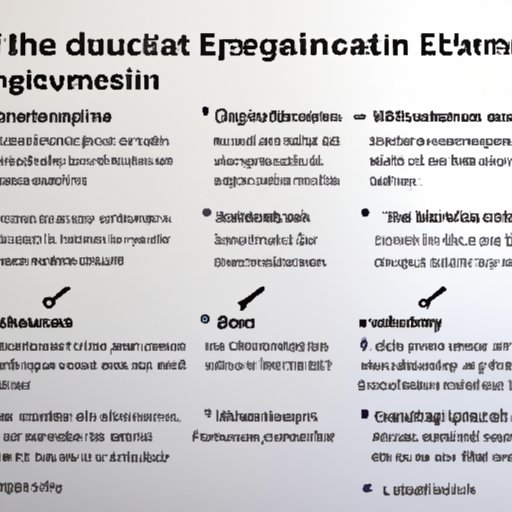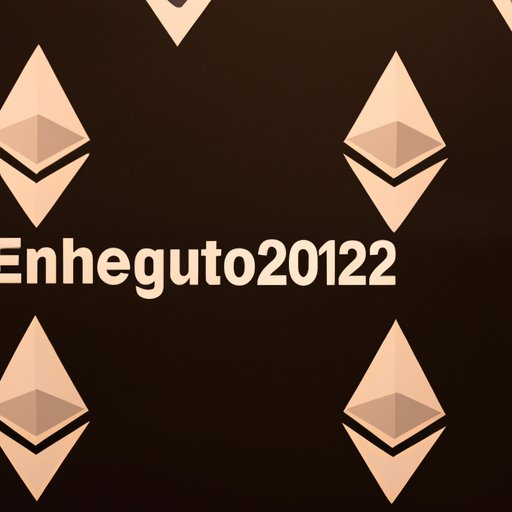Introduction
Ethereum 2.0 (also known as Eth2 or Serenity) is a major upgrade to the Ethereum blockchain that promises to improve scalability, security, and interoperability. It’s been in development since 2015 and has been eagerly anticipated by developers, businesses, and users alike. In this article, we’ll explore what Ethereum 2.0 is, how it works, and the potential impact it could have on the blockchain ecosystem.
What is Ethereum 2.0 and How Does it Work?
Before we dive into the specifics of Ethereum 2.0, let’s first take a look at the underlying Ethereum blockchain. Ethereum is a decentralized platform for creating and running distributed applications (known as Dapps). These Dapps are powered by smart contracts, which are digital agreements stored on the blockchain that can be used to automatically execute transactions. Ethereum also supports its own cryptocurrency, Ether (ETH), which is used to pay for transaction fees and rewards miners for verifying transactions.
Ethereum 2.0 is an upgrade to the existing Ethereum blockchain that introduces several new features. The primary goal of Ethereum 2.0 is to improve the scalability, security, and interoperability of the network. To achieve this, Ethereum 2.0 introduces a new consensus protocol called Proof of Stake (PoS). PoS replaces the current Proof of Work (PoW) consensus protocol, which requires miners to solve complex mathematical problems in order to verify transactions and earn rewards.
In addition to PoS, Ethereum 2.0 also introduces sharding. Sharding is a process by which the Ethereum blockchain is split into multiple shards, each of which is responsible for processing a certain portion of the blockchain’s data. By splitting the blockchain into multiple shards, Ethereum 2.0 can more efficiently process transactions, resulting in improved scalability.

Exploring the Benefits of Ethereum 2.0 for Businesses and Consumers
Ethereum 2.0 provides several benefits for businesses and consumers. For businesses, Ethereum 2.0 promises to increase the speed and efficiency of their operations. With improved scalability, businesses will be able to process more transactions in less time. This could lead to significant cost savings, as businesses won’t need to spend as much on transaction fees. Additionally, businesses will benefit from improved security, as the PoS consensus protocol is more secure than the PoW protocol.
Consumers will also benefit from Ethereum 2.0. With improved scalability, users will be able to send and receive payments more quickly, leading to faster and more efficient transactions. Additionally, users will benefit from improved security, as the PoS consensus protocol is more secure than the PoW protocol. Finally, users will benefit from increased interoperability, as Ethereum 2.0 will make it easier for users to interact with other blockchains.

Examining the Technical Details Behind Ethereum 2.0
Now that we’ve explored the benefits of Ethereum 2.0, let’s take a closer look at the technical details behind the upgrade. As mentioned above, Ethereum 2.0 introduces two main features – sharding and PoS. Let’s take a closer look at each of these features.
Understanding Ethereum Shards
As mentioned above, Ethereum 2.0 introduces sharding. Sharding is a process by which the Ethereum blockchain is split into multiple shards, each of which is responsible for processing a certain portion of the blockchain’s data. By splitting the blockchain into multiple shards, Ethereum 2.0 can more efficiently process transactions, resulting in improved scalability.
Exploring Ethereum’s New Consensus Protocol – Proof of Stake
In addition to sharding, Ethereum 2.0 also introduces a new consensus protocol called Proof of Stake (PoS). PoS replaces the current Proof of Work (PoW) consensus protocol, which requires miners to solve complex mathematical problems in order to verify transactions and earn rewards. Under the PoS protocol, instead of miners competing to solve mathematical problems, validators compete to hold the most ETH in a staking pool. The validator who holds the most ETH earns a reward for verifying transactions on the network.
Examining the Benefits of PoS for Scalability and Security
The introduction of PoS provides several benefits for scalability and security. First, PoS is more energy efficient than PoW, as it does not require miners to solve complex mathematical problems. This means that the network is able to process more transactions in less time, leading to improved scalability. Second, PoS is more secure than PoW, as it is more difficult for malicious actors to gain control of the network. Finally, PoS is more resilient to 51% attacks, as it is more difficult for malicious actors to acquire a majority of the stake in the network.
Potential Impact of Ethereum 2.0 on the Blockchain Ecosystem
Ethereum 2.0 promises to have a significant impact on the blockchain ecosystem. First, Ethereum 2.0 could improve interoperability between blockchains. By introducing features such as sharding and PoS, Ethereum 2.0 will make it easier for developers to create bridges between different blockchains, allowing them to communicate and interact with one another.
Second, Ethereum 2.0 could open up new opportunities for smart contract development. With improved scalability, developers will be able to create more complex and powerful smart contracts. Additionally, with improved security and resilience to 51% attacks, developers will be able to create more secure and reliable smart contracts.
Conclusion
Ethereum 2.0 is a major upgrade to the Ethereum blockchain that promises to improve scalability, security, and interoperability. This article has explored what you need to know about Ethereum 2.0, from its differentiating features to its potential impact on the blockchain ecosystem. Ethereum 2.0 could have a significant impact on the blockchain ecosystem, improving interoperability between blockchains and creating more opportunities for smart contract development.
Ethereum 2.0 is an exciting development for the blockchain ecosystem and one that many are eagerly anticipating. As the upgrade continues to move forward, we’ll continue to learn more about its features and potential impacts.
(Note: Is this article not meeting your expectations? Do you have knowledge or insights to share? Unlock new opportunities and expand your reach by joining our authors team. Click Registration to join us and share your expertise with our readers.)
